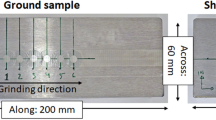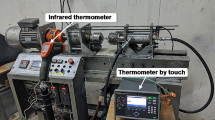Abstract
Surface finish has a vital influence on functional properties such as wear resistance and power loss due to friction on most of the engineering components. Magnetic abrasive finishing (MAF) is one of the advanced finishing process in which a surface is finished by removing the material in the form of microchips by abrasive particles in the presence of magnetic field in the finishing zone. In this study an electromagnet with four poles has been used which was found to give better performance in terms of achieving surface quality in lesser processing time. Voltage, mesh number, revolutions per minute (rpm) of electromagnet, and percentage weight of abrasives have been identified as important process parameters affecting surface roughness. The experiments were planned using response surface methodology and percentage change in surface roughness (ΔRa) was considered as response. Analysis of experimental data showed that percentage change in surface roughness (ΔRa) was highly influenced by mesh number followed by percentage weight of abrasives, rpm of electromagnet, and voltage. In this study, the least surface roughness value obtained was as low as 51 nm in 120 s processing time on a hardened AISI 52100 steel workpiece of 61 HRC hardness. In order to study the surface texture produced and to identify finishing mechanism, scanning electron microscopy and atomic force microscopy were also conducted. Shearing and brittle fracture of small portion of peaks of grounded workpiece have been found to be finishing mechanisms during MAF of AISI 52100 steel.
Similar content being viewed by others
References
Shinmura T, Takazawa K, Hatano E, Matsunaga M (1990) Study on magnetic abrasive finishing. Ann ClRP 39(l):325–328
Jain VK (2004) Advanced machining processes. Allied Publisher Pvt. Ltd., New Delhi
Lambropoulos JC, Miao C, Jacobs SD (2010) Magnetic field effects on shear and normal stresses in magnetorheological finishing. Opt Express 18(19):19713–19723
Fox M, Agrawal K, Shinmura T, Komanduri R (1994) Magnetic abrasive finishing of rollers. Ann CIRP 43(1):181–184
Yamguchi H, Shinmura T (2000) Study of an internal magnetic abrasive finishing using a pole rotation system: discussion of the characteristics abrasive behavior. Precis Eng 24:237–244
Jain VK, Kumar P, Behra PK, Jayswal SC (2001) Effect of working gap and circumferential speed on the performance of magnetic abrasive finishing process. Wear 250:384–390
Singh DK, Jain VK, Raghuram V (2005) On the performance of flexible magnetic abrasive brush. Mach Sci Technol 9:601–619
Singh DK, Jain VK, Raghuram V, Komanduri R (2005) Analysis of surface texture generated by a flexible magnetic abrasive brush. Wear 259:1254–1261
Singh DK, Jain VK, Raghuram V (2006) Experimental investigations into forces acting during a magnetic abrasive finishing process. Int J Adv Manuf Technol 30:652–662
Girma B, Joshi SS, Raghuram MVGS, Balasubramaniam R (2006) An experimental analysis of magnetic abrasives finishing of plane surfaces. Mach Sci Technol 10(3):323–340
Khairy AB (2001) Aspects of surface and edge finish by magnetoabrasive particles. J Mater Process Technol 116:77–83
Chang GW, Yan BH, Hsu RT (2002) Study on cylindrical magnetic abrasive finishing using unbonded magnetic abrasives. Int J Mach Tools Manuf 42:575–583
Yang LD, Lin CT, Chow HM (2009) Optimization in MAF operations using Taguchi parameter design for AISI304 stainless steel. Int J Adv Manuf Technol 42:595–605
Yin S, Shinmura T (2004) Vertical vibration-assisted magnetic abrasive finishing and deburring for magnesium alloy. Int J Mach Tools Manuf 44:1297–1303
Wang AC, Lee SJ (2009) Study the characteristics of magnetic finishing with gel abrasive. Int J Mach Tools Manuf 49:1063–1069
ASTM A 295/A 295 M–05
Montgomery DC (2001) Design and analysis of experiments. John Wiley & Sons (Asia), Singapore
Myers RH, Montgomery DC (2002) Response surface methodology: process and product optimization using designed experiments. Wiley, New York
Degarmo EP, Black JT, Kosher RA (2004) Materials and processes in manufacturing. Wiley (Asia), Singapore
Author information
Authors and Affiliations
Corresponding author
Rights and permissions
About this article
Cite this article
Mulik, R.S., Pandey, P.M. Magnetic abrasive finishing of hardened AISI 52100 steel. Int J Adv Manuf Technol 55, 501–515 (2011). https://doi.org/10.1007/s00170-010-3102-8
Received:
Accepted:
Published:
Issue Date:
DOI: https://doi.org/10.1007/s00170-010-3102-8




